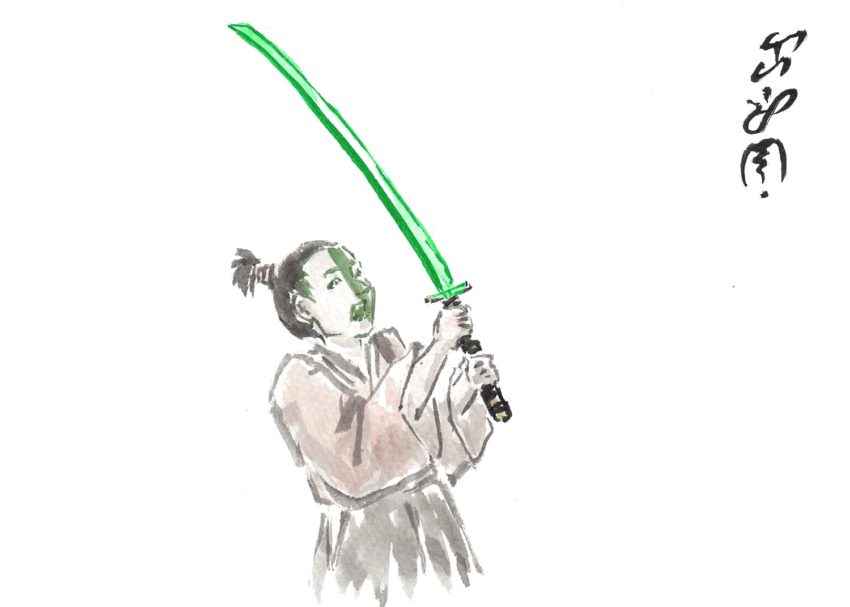Most cultures have their fair share of magical, sometimes malevolent, weapons. Japan is far from lacking in this department. Below, you will find several spine-tingling tales of cursed Japanese swords made over the centuries.
The Cursed Blades of Muramasa Sengo
Muramasa Sengo was a swordsmith during the Muromachi Period, between the 14th and 16th centuries. Muramasa’s school of weaponsmithing was well regarded for its ability to make quality blades with exceptional sharpness. The reason why this man’s work is being discussed in this article about cursed Japanese swords is because he seemed to put a bit too much of himself into his work: Muramasa was well-known for having an explosive and violent temper, a characteristic that seemed to taint his blades.
The man had been granted a certain kind of enviable swordmithing genius. But impulsive and indiscriminate bouts of rage, and a detrimental need to pursue perfection and madness, were traits that festered within the minds of those bearing one of his blades. Muramasa was also known to beseech any kamiKAMI 神 "god" learn more... who might listen to grant his current project the power to become a great destroyer.
The reasons that the blades of Muramasa are considered cursed Japanese swords are evident just from perusing the stories of their sinister nature:
- Some stories mention a Muramasa-wielder flying into a blindly berserk state that granted superhuman resilience and strength at the expense of the ability to distinguish ally from enemy.
- Another tale claims that his blades had an inhuman craving for blood. In these instances, a Muramasa that went too long without drawing the blood of another would compel its bearer to spill his own blood. It was said that Muramasa blades refused to be sheathed until someone’s blood had been tapped, leading to several suicides from individuals who somehow acquired a blade and merely intended to train with it. Further emphasizing their cursed nature, these tales claim that Muramasa blades compelled their bearers to seek out enemies in order to be “put to work.”
- Understandably, legends exist of Muramasa wielders succumbing to insanity. These “perfect killing tools” simply refused to be set aside and left idle. This is also how several mentions of suicidal owners appear. The unhinged warriors sought death as an escape from their bloodthirsty blades.
Tokugawa and the Cursed Japanese Swords of Muramasa
Like all nightmares, the evil of Muramasa’s blades eventually came to an end, specifically with the establishment of the Tokugawa Shogunate in 1603. Shogun Tokugawa Ieyasu believed in the horror stories about cursed Muramasa swords as many of them were responsible for killing those close to him, including his father Matsudaira Hirotada and his grandfather Matsudaira Kiyoyasu. Both of these Matsudaira clan leaders were slain by retainers bearing a Muramasa-made sword.
Tokugawa even stated that he had once been cut by a Muramasa wielded by one his own retainers, and that such a weapon was used to claim the lives of his wife and adopted son. These moments led to the belief that Muramasa blades were naturally inclined to crave Tokugawa clan blood. This piqued the interest of Ieyasu’s enemies, who acquired Muramasa weapons and didn’t see them merely as cursed Japanese swords.
Cursed Muramasa Swords That Still Exist
Ieyasu eventually banned all Muramasas from his domain, ordering that they be melted down or destroyed. Some blades were secreted away and altered to hide the traits that could identify them as a true Muramasa. Even with this dark history and the edict that anyone caught with such a blade was forced to commit seppukuSEPPUKU 切腹 "cutting the stomach" learn more..., Muramasa blades continued to rise in infamy as weapons of legend. This allure grew so great that some “enterprising” smiths did their best to forge replicas. Nowadays, anyone claiming to have an “authentic” Muramasa in his collection, or for sale, may very well be putting on airs. It is very hard to discern a real Muramasa from a copycat.
The Tale of Yukihira
This story concerns the work of a smith who went by the name of Yukihira; his real name was Kishin Dayu. One day, Yukihira was approached by an odd-looking young man, who expressed sorrow over being bullied in his village. Since his whole family had been expelled from the area, the young man asked Yukihira to forge him a weapon to take revenge against his enemies. Yukihira considered the severity of such a punishment and agreed to forge a blade for the man, despite suffering from serious hip pains.
As Yukihira worked on a 32-inch tachiTACHI 太刀 "great sword" learn more... for the man, he became fascinated by the process. Smiling from the sensation that he may well have been forging a masterpiece, he was able to keep his mind off the hip pain. When the young man came to collect his blade at the agreed-upon time, Yukihira apologized for being behind schedule and cited his injuries and old age. The weapon was incomplete; it only had a foundational polish and lacked a hilt. After many apologies, Yukihira handed over the blade to his client, whom seemed surprisingly upbeat. Even when Yukihira mentioned the missing hilt, the young man accepted the blade and took it back to his village.
After several days, the client returned to Yukihira with a broad smile on his face. He praised the smith’s work and said he was able to use it to extinguish every one of his enemies. Powerful but troublesome – like all good cursed Japanese swords!
The man then offered to apprentice under Yukihira as a way of thanking him and as a means of learning to make his own swords. Yukihira turned down the offer, believing that he would not live long enough to fully educate the young man. But the master was willing to humor the lad. Despite his misgivings, the boy seemed to have discovered a latent talent for swordsmithing and was miraculously able to produce an exceptional blade on his very first attempt.
A Change in Yukihira’s Fortunes
After some time had passed under this casual, faux master-apprentice arrangement, the boy came to Yukihira’s shop loaded with coins for the smith to buy raw materials. While Yukihira was overjoyed at this news, his hip problems flared up and left him unable to go buy the goods from the neighboring village. The apprentice worked while his master focused on recovering and produced a total of 66 swords in exceptionally swift time, each of them bearing Yukihira’s name.
After storing the assortment within a mountain cave behind the workshop, the apprentice addressed Yukihira. In his conversation, the man said that Yukihira’s old age meant that he should just enjoy his life, rather than toil around the heat of a forge. The apprentice then mentioned that he had made more than enough blades of various lengths for Yukihira to have a healthy nest egg upon retirement. Yukihira was moved to the point of tears and heartily thanked the young man for his work.
The man then continued to speak, mentioning that Brahma had appeared to him after taking revenge. The deity scolded the man for his actions and recommended he go into three years of hiding. Agreeing that this was a smart decision, the man had chosen to spend those three years working under Yukihira. After giving his thanks for Yukihira’s decision to make him an apprentice, the man disappeared, along with Yukihira’s hip troubles.
Publicizing the “Demon Swords”
While Yukihira was not so old that he could not still practice his craft, he was now free to take time off whenever he wanted thanks to the profits of his apprentice’s work. Whenever he would engage in sales talk, he would always make sure to mention that the blades were forged by a demon god and could cut mercilessly. Notably, the characters in “Kishin” can be rewritten to say “demonic god.” While this may not mean such blades are certifiably cursed Japanese swords, the expediency surrounding their creation and the mystery surrounding their creator certainly lends them to some level of malevolent influence.
One of Yukihira’s blades figures into Japanese history by way of daimyoDAIMYO 大名 "feudal lord" learn more... Hosokawa Yusai. Yusai was in charge of Tanabe Castle under the Tokugawa shogunate and eventually surrendered the besieged castle two days prior to the Battle of Sekigahara. After two refusals to surrender to non-artists and then receiving ccnfirmation that his great work, “Kokin Waka Shu,” would be preserved and distributed via imperial order, Yusai accepted the terms of surrender. Yusai also handed over a tachi, crafted by Yukihira and considered his personal favorite blade, to Karasumaru Mitsuhiro, a poet who represented one-third of the final detachment of envoys requesting he surrender the castle to Ishida Matsunari’s force of 15,000 men.
Today, the tachi that was first owned by Hosokawa Yusai is known as Kokindenju-Yukihira and it is regarded as a national treasure of Japan. Karasumaru’s clan maintained ownership of the blade for several generations until it was acquired by Nakayama Takamaro. Looking to make a decent amount of money from a weapon several centuries old, Takamaro put the blade up for bidding in June 1929. The tachi was swiftly purchased by Hosokawa Moritatsu, the 16th generation head of the Hosokawa clan and grandfather to Hosokawa Morihiro, a man who would later become Japan’s prime minister. Moritatsu was overjoyed to have returned the sword to the family to which it had once belonged.
Are There Still Cursed Japanese Swords Today?
If any Japanese katana or tachi were every truly cursed – and you can choose to believe there were or weren’t – then there are still some around today that carry curses. Most swords would be cursed due to their notable histories or the fame of their makers, and would likely be valuable museum pieces. And, as mentioned, forgeries may exist that further muddy the waters.
Either way, if you are interested in so-called cursed Japanese swords for your collection and enjoyment, look for a nice replica that isn’t priced too high. A fake can be beautiful if made with care.
Alternatively, pick one of your favorite swords from your collection and start a new tale of its curse. These stories have to start somewhere; why not make your own specific to you and your blade? Let your creativity free – you may own a cursed sword right now!

